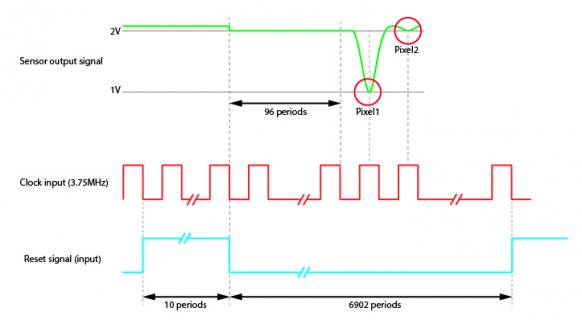Hi all,
I have taken apart a Canon LIDE scanner and am trying to read the pixel values directly from the linear image sensor.
The sensor contains a small IC that needs a clock and a reset signal as input and output the pixel values as analog voltages between 1 and 2 Volts. 1V corresponds to a white pixel and 2V is black.
The scanner main PCB sends a 3.75 MHz clock, which sounds pretty fast. I suppose slowing that down will just increase the integration time and result in brighter pixels.
A "reset" signal tells the sensor to go back to the first pixel and starts a new line. The sensor shifts pixel at each clock cycle. The sensor output signal drops to the pixel value voltage when the clock is high and goes back to 2V between pixels.
The image below makes probably more sense than my explanations...

Do you guys think it is possible to interface this with a Teensy? Has anyone around here played with these sensors before?
I started looking at FTM timers with the idea of outputting clock and reset signals and hopefully triggering the ADC when clock is high. The readings can then be streamed to an SD card or a the PC
The signal generation/ADC trigger mean quite a bit of fiddling with registers and probably interrupts to get that right.
Is there an easier approach?
I have taken apart a Canon LIDE scanner and am trying to read the pixel values directly from the linear image sensor.
The sensor contains a small IC that needs a clock and a reset signal as input and output the pixel values as analog voltages between 1 and 2 Volts. 1V corresponds to a white pixel and 2V is black.
The scanner main PCB sends a 3.75 MHz clock, which sounds pretty fast. I suppose slowing that down will just increase the integration time and result in brighter pixels.
A "reset" signal tells the sensor to go back to the first pixel and starts a new line. The sensor shifts pixel at each clock cycle. The sensor output signal drops to the pixel value voltage when the clock is high and goes back to 2V between pixels.
The image below makes probably more sense than my explanations...

Do you guys think it is possible to interface this with a Teensy? Has anyone around here played with these sensors before?
I started looking at FTM timers with the idea of outputting clock and reset signals and hopefully triggering the ADC when clock is high. The readings can then be streamed to an SD card or a the PC
The signal generation/ADC trigger mean quite a bit of fiddling with registers and probably interrupts to get that right.
Is there an easier approach?

